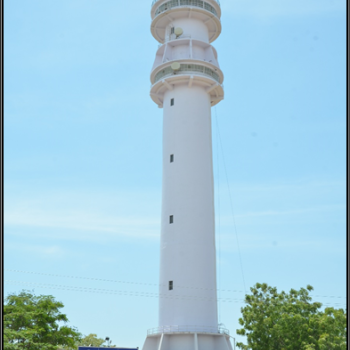Bhadreshwar Vts Repeater And Lighthouse Station
DGLL Light House Location

Bhadreshwar is the site of the ancient city of Bhadravati. Most of the ruins have been carried away, and even the foundations having been dug up for building stone. Bhadravati is mentioned in epic Mahabharata. It is mentioned in the works of Kantavijay, a Jain monk.
The earliest source of information regarding this place is an inscription on the Ajitnath statue in Vasai Jain temple which records Samvat 622 (555 AD) which may be marking Samvat 1622 (1565 AD) also. The Vasai Jain Temple is said to have been founded in the 21st year of the Vairat era, and dedicated to Vasai by Siddhasen of the race of Hari. His successors were Mahasen, Narsen, Bhojraj, Vanraj, Sarangdev, Virasen, and Harisen, who lived in the time of Vikram (57 BC). Harisen had left his kingdom to his widow Lilavati. Lilavati was succeeded by his nephew Kirtidhara. Then came Dharnipal, Devdatt and Danjiraj. In the time of Dhaniraj, the country was plundered by many chiefs.
In 156, (Samvat 213), Vanraj Vaghela of Munjpur, who was Jain, seized the country. He was succeeded by Yograj, Ratnadatta or Shivaditya and Vijayarao or Vaisiddha. Next, after a time of misrule, the Kathis of Pavargadh seized Bhadravati and kept it for 147 years. After them, 651 (Samvat 618), Kanak Chavda of Patan took the country, built the temple, and in 555 (Samvat 622) set up the statue of Ajitnath which may be brought in to fit the date on the statue. Kanak's successor was Akad Chavda, a Shaiva. During his time, the village was invaded by Sayyid Lal Shah and Mughals. He was followed by his son Bhuvad who lost his kingdom to the Solanki Rajputs of Bhangadh. The new rulers changed the name of the place to Bhadreshwar in 741 (Samvat 798), and continued to hold it until 1132 (Samvat 1189). Navghan, the son of Bhimrao, was the last of them.
The other statues of the Jain temple mark Samvat 1232 (1175 AD) as their dates. Perhaps the earliest historical fact is that in Samvat 1182 (1125 AD), Jagdusha, a Jain merchant and philanthropist who had made a fortune as a grain dealer in a time of famine, received a grant of Bhadreshwar and had the temple so thoroughly repaired that all traces of antiquity were removed. He died without heirs in 1181 (Samvat 1238) and the village fell into the hands Naughan Vaghela and his vakils AjjaramalShantidas and Nagandas Tejpal. Vastupal-Tejapal, the ministers in court of Viradhaval of Vaghela dynasty visited the temple with Sangha in Samvat 1286 and was well received by Navghan. They managed to convince Viradhaval to get his daughter married with Sarangdev, the grandson of Navghan. In the twelfth and thirteenth centuries this was a most popular place of pilgrimage among Jains.
Under the Jadejas, it was seized by Jam Hala and afterwards by Jam Raval in 1535 (Samvat 1592). HalaDungarji, the relation of Rao Bharmalji, seized the temple- lands and Rao had to visit in Samavat 1659 to arrange matters between the Jains and him. In 1693, it was plundered by Muslim forces led by Mohsum Beg and many of the images were broken. Since then it has been neglected. In 1763, the walls of the old fort began to be pulled down and the stones used for building. About 1810 even the old temples were razed to supply stones to build the seaport town of Mundra.
On 15 December 1815, the army of Cutch State was defeated near Bhadreshwar. The army of the British East India Company was led by Colonel East and the army of Cutch was led by a Muslim commander, Hussain Miyan met near Bhadreshwar. The British army was behind the Vasai Jain Temple and the temple was in between them. Husain Miyan respected the sanctity of the temple and he didn't fire on the British, fearing the temple might be damaged. The British army won and occupied the fortified town of Anjar, port of Tuna and adjacent villages by 25 December 1815. This led to negotiations between the Cutch and British rulers. The Jadeja rulers of Kutch accepted the suzerainty of the British in 1818 and Captain James MacMurdo was posted as British Political Resident stationed at Bhuj. The Anjar district, however, remained under direct occupation of British forces for seven years until 25 December 1822, when it was handed back to Cutch State by an agreement.
After the independence of India in 1947, Kutch State acceded unto the dominion of India and was constituted an independent commissionaire, Kutch State. In 1956, Kutch State was merged with Bombay state, which in 1960 was divided into the new linguistic states of Gujarat and Maharashtra, with Kutch becoming part of Gujarat state. Bhadreshwar now falls under Mundra Taluka of Kutch district.
Subsequently on development of VTS in GoK a repeater station for VTS-GoK project a 60mhigh RCC tower has been constructed and the Main Light SL300-1D5-1 was set up on top of the tower for Aids to mariners.
Lighthouse Equipment – The SL-300-1D5-1 series are 13 to 21NM long-range marine lanterns with 1.5 degree vertical distribution, suitable for a range of day and night applications with advanced PC or IR programming. High Intensity, Small Form Factor The SL-300-1D5 series offers multiple intensity adjustments to over 90,000cd luminous intensity in a single tier (over 180,000cd in a 2-tier configuration). The small form factor provides minimal wind loading and convenient handling – delivering significant advantages over traditional larger lens stack assemblies. High Efficiency long-range lanterns produce a class-leading intensity to power ratio, making them highly efficient & suitable for solar power solutions. The existing TRB-220 replaced with stationery Marine high intensity LED flasher unit on 12.03.2022.
Master Ledger of Bhadreshwar Vts Repeater And Lighthouse Station(1.22 MB) Click here for Main Website
Click here for Main Website










